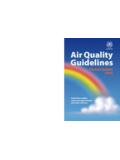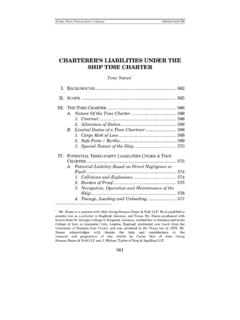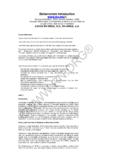Transcription of SAFETY DATA SHEET - Stepan Company
1 SAFETY data SHEET . 1. Identification Product identifier PETROSTEP ES-65A. Other means of identification Product code 0965. Recommended use Surfactant Recommended restrictions For industrial use only. Manufacturer/Importer/Supplier/Distribut or information Manufacturer Company name Stepan Company Address 22 West Frontage Road Northfield, IL 60093. USA. Telephone General 1-847-446-7500. E-mail Not available. Emergency phone number Medical 1-800-228-5635. Chemtrec 1-800-424-9300. Chemtrec Int'l +1 703-527-3887. 2. Hazard(s) identification Physical hazards Flammable liquids Category 3. Health hazards Skin corrosion/irritation Category 2. Serious eye damage/eye irritation Category 1. Environmental hazards Hazardous to the aquatic environment, acute Category 2. hazard Hazardous to the aquatic environment, Category 3. long-term hazard OSHA defined hazards Not classified.
2 Label elements Signal word Danger Hazard statement Flammable liquid and vapor. Causes skin irritation. Causes serious eye damage. Toxic to aquatic life. Harmful to aquatic life with long lasting effects. Precautionary statement Prevention Keep container tightly closed. Keep away from heat/sparks/open flames/hot surfaces. - No smoking. Ground/bond container and receiving equipment. Use explosion-proof electrical/ventilating/lighting equipment. Use only non-sparking tools. Take precautionary measures against static discharge. Wash thoroughly after handling. Avoid release to the environment. Wear protective gloves/eye protection/face protection. Response If on skin (or hair): Take off immediately all contaminated clothing. Rinse skin with water/shower. If in eyes: Rinse cautiously with water for several minutes. Remove contact lenses, if present and easy to do.
3 Continue rinsing. Immediately call a poison center/doctor. Specific treatment (see this label). If skin irritation occurs: Get medical advice/attention. Take off contaminated clothing and wash before reuse. In case of fire: Use appropriate media to extinguish. Storage Store in a well-ventilated place. Keep cool. Disposal Dispose of contents/container in accordance with local/regional/national/international regulations. Hazard(s) not otherwise None known. classified (HNOC). Supplemental information Not applicable. Material name: PETROSTEP ES-65A SDS US. Material ID: 6390 Product code: 0965 Version #: 03 Revision date: 08-21-2018 Print date: 08-21-2018 1/8. 3. Composition/information on ingredients Mixtures Chemical name Common name and synonyms CAS number %. _Ammonium alcohol (C6-10) ether 68037-05-8 60 - 65. sulfate Water 7732-18-5 20 - < 30. Isopropanol 67-63-0 8 - 12.
4 Other components below reportable levels <1. 4. First-aid measures Inhalation Move to fresh air. Call a physician if symptoms develop or persist. Skin contact Take off immediately all contaminated clothing. Rinse skin with water/shower. If skin irritation occurs: Get medical advice/attention. Take off contaminated clothing and wash before reuse. Eye contact Immediately flush eyes with plenty of water for at least 15 minutes. Remove contact lenses, if present and easy to do. Continue rinsing. Get medical attention immediately. Ingestion Rinse mouth. Get medical attention if symptoms occur. Do not induce vomiting without advice from poison control center. Most important Symptoms may include stinging, tearing, redness, swelling, and blurred vision. Skin irritation. May symptoms/effects, acute and cause redness and pain. delayed Indication of immediate Provide general supportive measures and treat symptomatically.
5 Thermal burns: Flush with water medical attention and special immediately. While flushing, remove clothes which do not adhere to affected area. Call an treatment needed ambulance. Continue flushing during transport to hospital. Keep victim under observation. Symptoms may be delayed. General information Take off all contaminated clothing immediately. Ensure that medical personnel are aware of the material(s) involved, and take precautions to protect themselves. Wash contaminated clothing before reuse. 5. Fire-fighting measures Suitable extinguishing media Alcohol resistant foam. Water fog. Carbon dioxide (CO2). Dry chemical powder, carbon dioxide, sand or earth may be used for small fires only. Unsuitable extinguishing Do not use water jet as an extinguisher, as this will spread the fire. media Specific hazards arising from Vapors may form explosive mixtures with air.
6 Vapors may travel considerable distance to a source the chemical of ignition and flash back. This product is a poor conductor of electricity and can become electrostatically charged. If sufficient charge is accumulated, ignition of flammable mixtures can occur. To reduce potential for static discharge, use proper bonding and grounding procedures. This liquid may accumulate static electricity when filling properly grounded containers. Static electricity accumulation may be significantly increased by the presence of small quantities of water or other contaminants. Material will float and may ignite on surface of water. During fire, gases hazardous to health may be formed. Special protective equipment Self-contained breathing apparatus and full protective clothing must be worn in case of fire. and precautions for firefighters Fire fighting In case of fire and/or explosion do not breathe fumes.
7 Move containers from fire area if you can do equipment/instructions so without risk. Specific methods Use standard firefighting procedures and consider the hazards of other involved materials. General fire hazards Flammable liquid and vapor. 6. Accidental release measures Personal precautions, Keep unnecessary personnel away. Keep people away from and upwind of spill/leak. Keep out of protective equipment and low areas. Eliminate all ignition sources (no smoking, flares, sparks, or flames in immediate area). emergency procedures Wear appropriate protective equipment and clothing during clean-up. Do not touch damaged containers or spilled material unless wearing appropriate protective clothing. Ventilate closed spaces before entering them. Use appropriate containment to avoid environmental contamination. Local authorities should be advised if significant spillages cannot be contained.
8 Material name: PETROSTEP ES-65A SDS US. Material ID: 6390 Product code: 0965 Version #: 03 Revision date: 08-21-2018 Print date: 08-21-2018 2/8. Methods and materials for Eliminate all ignition sources (no smoking, flares, sparks, or flames in immediate area). Take containment and cleaning up precautionary measures against static discharge. Use only non-sparking tools. Keep combustibles (wood, paper, oil, etc.) away from spilled material. Large Spills: Stop the flow of material, if this is without risk. Dike the spilled material, where this is possible. Cover with plastic SHEET to prevent spreading. Use a non-combustible material like vermiculite, sand or earth to soak up the product and place into a container for later disposal. Prevent entry into waterways, sewer, basements or confined areas. Following product recovery, flush area with water. Small Spills: Wipe up with absorbent material ( cloth, fleece).
9 Clean surface thoroughly to remove residual contamination. Never return spills to original containers for re-use. Environmental precautions Avoid release to the environment. Contact local authorities in case of spillage to drain/aquatic environment. Prevent further leakage or spillage if safe to do so. Do not contaminate water. Avoid discharge into drains, water courses or onto the ground. Use appropriate containment to avoid environmental contamination. 7. Handling and storage Precautions for safe handling Vapors may form explosive mixtures with air. Do not handle, store or open near an open flame, sources of heat or sources of ignition. Protect material from direct sunlight. Do not smoke. Minimize fire risks from flammable and combustible materials (including combustible dust and static accumulating liquids) or dangerous reactions with incompatible materials.
10 Handling operations that can promote accumulation of static charges include but are not limited to: mixing, filtering, pumping at high flow rates, splash filling, creating mists or sprays, tank and container filling, tank cleaning, sampling, gauging, switch loading, vacuum truck operations. Take precautionary measures against static discharges. All equipment used when handling the product must be grounded. Use non-sparking tools and explosion-proof equipment. Avoid contact with skin. Avoid contact with eyes. Avoid prolonged exposure. Avoid contact with clothing. Provide adequate ventilation. Wear appropriate personal protective equipment. Observe good industrial hygiene practices. Avoid release to the environment. Do not empty into drains. Conditions for safe storage, Keep away from heat, sparks and open flame. Prevent electrostatic charge build-up by using including any incompatibilities common bonding and grounding techniques.













